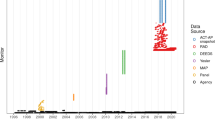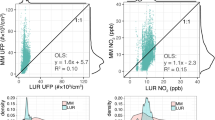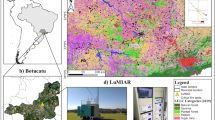Abstract
Although intra-urban air pollution differs by season, few monitoring networks provide adequate geographic density and year-round coverage to fully characterize seasonal patterns. Here, we report winter intra-urban monitoring and land-use regression (LUR) results from the New York City Community Air Survey (NYCCAS). Two-week integrated samples of fine particles (PM2.5), black carbon (BC), nitrogen oxides (NOx) and sulfur dioxide (SO2) were collected at 155 city-wide street-level locations during winter 2008–2009. Sites were selected using stratified random sampling, randomized across sampling sessions to minimize spatio-temporal confounding. LUR was used to identify GIS-based source indicators associated with higher concentrations. Prediction surfaces were produced using kriging with external drift. Each pollutant varied twofold or more across sites, with higher concentrations near midtown Manhattan. All pollutants were positively correlated, particularly PM2.5 and BC (Spearman’s r=0.84). Density of oil-burning boilers, total and truck traffic density, and temporality explained 84% of PM2.5 variation. Densities of total traffic, truck traffic, oil-burning boilers and industrial space, with temporality, explained 65% of BC variation. Temporality, built space, bus route location, and traffic density described 67% of nitrogen dioxide variation. Residual oil-burning units, nighttime population and temporality explained 77% of SO2 variation. Spatial variation in combustion-related pollutants in New York City was strongly associated with oil-burning and traffic density. Chronic exposure disparities and unique local sources can be identified through year-round saturation monitoring.
This is a preview of subscription content, access via your institution
Access options
Subscribe to this journal
Receive 6 print issues and online access
$259.00 per year
only $43.17 per issue
Buy this article
- Purchase on Springer Link
- Instant access to full article PDF
Prices may be subject to local taxes which are calculated during checkout






Similar content being viewed by others
References
Brunekreef B, Janssen NAH, Hartog J, Harssema H, Knape M, van Vliet P . Air pollution from truck traffic and lung function in children living near motorways. Epidemiology 1997; 8: 298–303.
Lindgren A, Björk J, Stroh E, Jakobsson K . Adult asthma and traffic exposure at residential address, workplace address, and self-reported daily time outdoor in traffic: a two-stage case-control study. BMC Pub H 2010; 10: 716.
Hoek G, Brunekreef B, Goldbohm S, Fischer P, van den Brandt P . Association between mortality and indicators of traffic-related air pollution in the Netherlands: a cohort study. Lancet 2002; 360: 1203–1209.
Pope CA, Ezzati M, Dockery DW . Fine-particulate air pollution and life expectancy in the United States. New Eng J Med 2009; 360: 376–386.
Brauer M, Hoek G, Van Vliet P, Meliefste K, Fischer PH, Wijga A et al Air pollution from traffic and the development of respiratory infections and asthmatic and allergic symptoms in children. Am J Resp Crit Care Med 2002; 166: 1092–1098.
Hochadel M, Heinrich J, Gehring U, Morgenstern V, Kuhlbusch T, Link E et al Predicting long-term average concentrations of traffic-related air pollutants using GIS-based information. Atmos Environ 2006; 40: 542–553.
Wheeler AJ, Smith-Doiron M, Xu X, Gilbert NL, Brook JR . Intra-urban variability of air pollution in Windsor, Ontario—Measurement and modeling for human exposure assessment. Environ Res 2008; 106: 7–16.
Clougherty JE, Wright RJ, Baxter LK, Levy JI . Land use regression modeling of intra-urban variability in multiple traffic-related air pollutants. Environ Health 2008; 7: 17.
Lebret E, Briggs DJ, Collins S, van Reeuwijk H, Fischer P, Smallbone K et al Small area variations in ambient NO2 concentrations in four European areas. Atmos Environ 2000; 34: 177–185.
Bell ML, Ebisu K, Peng RD, Samet JM, Dominici F . Hospital admissions and chemical composition of fine particle air pollution. Am J Resp Crit Care Med 2009; 179: 1115–1120.
Patel MM, Hoepner L, Garfinkel R, Chillrud S, Reyes A, Quinn JW et al Ambient metals, elemental carbon, and wheeze and cough in New York City children through age 24 months. Am J Resp Crit Care Med 2009; 180: 1107–1113.
Roberts JR, Young S-H, Castranova V, Antonini JM . The soluble nickel component of residual oil fly ash alters pulmonary host defense in rats. J Immunotoxicol 2009; 6: 49–61.
Qin YJ, Kim E, Hopke PK . The concentrations and sources of PM2.5 in metropolitan New York City. Atmos Environ 2006; 40: S312–S332.
Ross Z, Jerrett M, Ito K, Tempalski B, Thurston GD . A land use regression for predicting fine particulate matter concentrations in the New York City region. Atmos Environ 2007; 41: 2255–2269.
Kinney PL, Aggarwal M, Northridge ME, Janssen NAH, Shepard P . Airborne concentrations of PM2.5 and diesel exhaust particles on Harlem Sidewalks: a community-based pilot study. Environ Health Perspect 2000; 108: 213–218.
Matte TD, Ross Z, Kheirbek I, Eisl H, Johnson S, Gorczynski JE et al Monitoring intra-urban spatial patterns of multiple combustion air pollutants in New York City: Design and Implementation. J Expo Sci Environ Epidemiol, advance online publication 16 January 2013.
Su JG, Jerrett M, Beckerman B . A distance-decay variable selection strategy for land use regression modeling of ambient air pollution exposures. Sci Tot Environ 2009; 407: 3890–3898.
Pearce JL, Rathbun SL, Aguilar-Villalobos M, Naeher LP . Characterizing the spatiotemporal variability of PM2.5 in Cusco, Peru using kriging with external drift. Atmos Environ 2009; 43: 2060–2069.
Briggs DJ, Collins S, Elliott P, Fischer P, Kingham S, Lebret E et al Mapping urban air pollution using GIS: a regression-based approach. Int J GIS 1997; 11: 699–718.
Cyrys J, Heinrich J, Hoek G, Meliefste K, Lewne M, Gehring U et al Comparison between different traffic-related particle indicators: elemental carbon (EC), PM2.5 mass, and absorbance. J Expo Anal Environ Epidemiol 2003; 13: 134–143.
Brauer M, Hoek G, Van Vliet P, Meliefste K, Fischer P, Gehring U et al Estimating long-term average particulate air pollution concentrations: application of traffic indicators and geographic information systems. Epidemiology 2003; 14: 228–239.
Jerrett M, Arain MA, Kanaroglou P, Beckerman B, Crouse D, Gilbert NL et al Modeling the intraurban variability of ambient traffic pollution in Toronto, Canada. J Toxicol Environ Health A 2007; 70: 200–212.
Lena TS, Ochieng V, Carter M, Holguin-Veras J, Kinney PL . Elemental carbon and PM2.5 levels in an urban community heavily impacted by truck traffic. Environ Health Perspect 2002; 110: 1009–1015.
Maciejczyk PB, Offenberg JH, Clemente J, Blaustein M, Thurston GD, Chen LC . Ambient pollutant concentrations measured by a mobile laboratory in South Bronx, NY. Atmos Environ 2004; 38: 5283–5294.
Kheirbek I, Johnson S, Ross Z, Pezeshki G, Ito K, Eisl H et al Spatial variability in levels of benzene, formaldehyde, and total benzene, toluene, ethylbenzene and xylenes in New York City: a land-use regression study. Environ Health 2012; 11: 51.
Acknowledgements
We are very grateful to the many individuals who have contributed to the planning and implementation of NYCCAS, including Janice Kim, Bart Ostro, Michael Jerrett, Jonathan Levy, George Thurston, Patrick Kinney, Michael Brauer, James Bryan Jacobson, Hollie Kitson, Alyssa Benson, Andres Camacho, Jordan Werbe-Fuentes, Jonah Haviland-Markowitz, Rolando Munoz, Anna Tilles, Carter H. Strickland and Kizzy Charles-Guzman. This work was supported by the City of New York Department of Health and Mental Hygiene, and NYC Mayor’s Office of Long-Term Planning and Sustainability.
Author information
Authors and Affiliations
Corresponding author
Ethics declarations
Competing interests
The authors declare no conflict of interest.
Additional information
Supplementary Information accompanies the paper on the Journal of Exposure Science and Environmental Epidemiology website
Rights and permissions
About this article
Cite this article
Clougherty, J., Kheirbek, I., Eisl, H. et al. Intra-urban spatial variability in wintertime street-level concentrations of multiple combustion-related air pollutants: The New York City Community Air Survey (NYCCAS). J Expo Sci Environ Epidemiol 23, 232–240 (2013). https://doi.org/10.1038/jes.2012.125
Received:
Revised:
Accepted:
Published:
Issue Date:
DOI: https://doi.org/10.1038/jes.2012.125
Keywords
This article is cited by
-
Clean fleets, different streets: evaluating the effect of New York City’s clean bus program on changes to estimated ambient air pollution
Journal of Exposure Science & Environmental Epidemiology (2023)
-
Machine Learning Approaches for Measuring Neighborhood Environments in Epidemiologic Studies
Current Epidemiology Reports (2022)
-
Spatial regression modelling of particulate pollution in Calgary, Canada
GeoJournal (2022)
-
Using a network of lower-cost monitors to identify the influence of modifiable factors driving spatial patterns in fine particulate matter concentrations in an urban environment
Journal of Exposure Science & Environmental Epidemiology (2020)
-
Development and validation of a method to quantify benefits of clean-air taxi legislation
Journal of Exposure Science & Environmental Epidemiology (2020)



